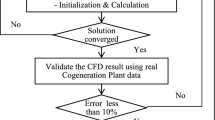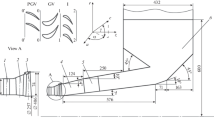Abstract
An innovative idea of extracting kinetic energy from man-made wind resources using ducted turbine system for on-site power generation is introduced in this paper. A horizontal axis ducted turbine is attached to the top of the chimney to harness the kinetic energy of flue gases for producing electricity. The turbine system is positioned beyond the chimney outlet, to avoid any negative impact on the chimney performance. The convergent-divergent duct causes increase in the flue gas velocity and hence enhances the performance of the turbine. It also acts as a safety cover to the energy recovery system. The results from the CFD based simulation analysis indicate that significant power 34 kW can be harnessed from the chimney exhaust. The effect of airfoils NACA4412 and NACA4416 and the diffuser angle on the power extraction by the energy recovery system using a 6-bladed ducted turbine has been studied with the CFD simulation. It is observed that the average flue gas velocity in the duct section at the throat is approximately twice that of the inlet velocity, whereas maximum velocity achieved is 2.6 times the inlet velocity. The simulated results show that about power may be extracted from the chimney flue gases of 660 MW power plant. The system can be retrofitted to existing chimneys of thermal power plants, refineries and other industries.















Similar content being viewed by others
Abbreviations
- V :
-
Average velocity of flue gases
- \(\dot{m}\) :
-
Mass flow rate of flue gases
- ρ :
-
Flue gas density
- U :
-
Free stream velocity
- T :
-
Temperature of flue gases at inlet
- P 1 :
-
Pressure of flue gases at duct inlet
- P 2 :
-
Atmospheric Pressure of flue gases
- \(u, v, w\) :
-
Velocity components of flue gases
- R :
-
Turbine rotor radius
- ω :
-
Angular velocity, rate of eddy dissipation
- P :
-
Power
- τ :
-
Torque
- C T :
-
Coefficient of torque
- C P :
-
Coefficient of power
- λ :
-
Tip speed ratio
- η :
-
Efficiency
- α :
-
Angle of attack
- θ :
-
Diffuser angle
- q :
-
Heat transfer
- k :
-
Variance of velocity fluctuations
- ɛ :
-
Turbulence eddy dissipation
References
CHILUGODU N, YOON Y-J, CHUA KS, et al. Simulation of train induced forced wind draft for generating electrical power from Vertical Axis Wind Turbine (VAWT) [J]. International Journal of Precision Engineering and Manufacturing, 2012, 13(7): 1177–1181.
CHIKERE A O, AL-KAYIEM H H, ABDU Z A. Review on the enhancement techniques and introduction of an alternate enhancement techniques of solar chimney power plant [J]. Journal of Applied Sciences, 2011, 11(11): 1877–1884.
GOH K H, DUAN F. Performance of a prototype micro wind turbine in the manmade wind field from air conditioner of buildings [J]. QScience Connect 2013: 4.
MANWELL J F, MCGOWAN J G, ROGERS A L. Wind Energy Explained: Theory, Design and Application[M]. Chichester, England: John Wiley & Son Ltd., 2002.
FOREMAN K M, GILBERT B, OMAN R A. Diffuser augmentation of wind turbines[J]. Solar Energy, 1978, 20: 305–311.
LAWN C J. Optimization of the power output from ducted turbines [J]. Journal of Power and Energy, 2003, 217: 107–117.
BET F, GRASSMANN H. Upgrading conventional wind turbines [J]. Renewable Energy, 2003, 28(1): 71–78.
GRANT A, KELLY N. The development of a ducted wind turbine simulation model [C]//8th International IBPSA Conference, Eindhoven, Netherlands. August 11–14, 2003.
GRANT A, JOHNSTONE C, KELLY N. Urban wind energy conversion: The potential of ducted turbines [J]. Renewable Energy, 2008, 33: 1157–1163.
ABE K, NISHIDA M, SAKURAI A, et al. Experimental and numerical investigations of flow fields behind a small wind turbine with a flanged diffuser [J].Journal of Wind Engineering and Industrial Aerodynamics, 2005, 93:951–970.
MATSUSHIMA T, TAKAGI S, MUROYAMA S. Characteristics of a highly efficient propeller type small wind turbine with a diffuser[J]. Renewable Energy, 2006, 31: 1343–1354.
OHYA Y, KARASUDANI T, SAKURAI A, et al. Development of a shrouded wind turbine with a flanged diffuser[J]. Journal of Wind Engineering and Industrial Aerodynamics, 2008, 96: 524–539.
ISENSEE G M, RAZZAK H A. Modeling and analysis of diffuser augmented wind turbine[J]. International Journal of Energy Science, 2012, 2(3): 84–88.
Van BUSSEL G J W. The science of making more torque from wind: Diffuser experiments and theory revisited [J]. Journal of Physics: Conference Series, 2007, 75: 1–13.
HANSEN, M O L. Aerodynamics of Wind Turbines [B]. Sterling, VA: Earthscan, 2008.
HU S, CHENG J. Innovatory designs for ducted wind turbines [J]. Renewable Energy, 2008, 33: 1491–1498.
CHEN T Y, LIAO Y T, CHENG C C. Development of small wind turbines for moving vehicles: Effects of flanged diffusers on rotor performance [J]. Experimental Thermal and Fluid Science, 2012, 42: 136–142.
CHAUDHARI C D, WAGHMARE S A, KOTWAL A P. “Numerical analysis of venturi ducted horizontal axis wind turbine for efficient power generation [J]. International Journal of Mechanical Engineering and Computer Applications, 2013, 1(5): 90–93.
WANG J, PIECHNA J, MULLER N. Computational fluid dynamics investigation of a novel multiblade wind turbine in a duct [J]. Journal of Solar Energy Engineering, 2013, 135: 011007-1-6.
ARANAKE A C, LAKSHMINARAYAN V K, DURAISAMY K. Computational analysis of shrouded wind turbine configurations [C]//51st AIAA Aerospace Sciences Meeting including the New Horizons Forum and Aerospace Exposition, Grapevine (Dallas/Ft. Worth Region), Texas, January 7–10, 2013.
MONTEIRO J P, SILVESTRE M R, PIGGOTT H, et al. Wind tunnel testing of a horizontal axis wind turbine rotor and comparison with simulations from two Blade Element Momentum codes [J]. Journal of Wind Engineering and Industrial Aerodynamics, 2013, 123: 99–106.
AHMED N A, CAMERON M. The challenges and possible solutions of horizontal axis wind turbines as a clean energy solution for the future [J]. Renewable and Sustainable Energy Reviews, 2014, 38: 439–460.
VENKATESH G. Power production technique using exhaust gas from present automobiles via convergent-divergent nozzle [C]//IEEE Conference on Electric and Hybrid Vehicles (ICEHV’06), Pune, India. December 18–20, 2006.
PEER A, PRABHAKAR G. Realization of exhaust air recovery and waste heat recovery systems for energy conservation and sustainable development [J]. Journal of Energy Technologies and Policy, 2012, 2(7): 39–43.
HASAN M A, HOSSAIN M T, PAUL R, et al. Producing electrical energy by using wastage wind energy from exhaust fans of industries [J]. International Journal of Scientific & Engineering Research, 2013, 4(8): 1184–1187.
PATNAIK A, ALI S M. Industrial exhaust fans as source of power [J]. International Journal of Electrical, Electronics and Data Communication, 2013, 1(9): 38–42.
CHONG W T, POH S C, FAZLIZAN A, et al. Exhaust air and wind energy recovery system for clean energy generation [C]//2011International Conference on Environment and Industrial Innovation (IPCBEE 2011), Kuala Lumpur: IACSIT, Singapore, 2011.
CHONG W T, POH S C, FAZLIZAN A, et al. Early development of an energy recovery wind turbine generator for exhaust air system [J]. Applied Energy, 2013, 112: 568–575.
CHONG W T, HEW W P, YIP S Y, et al. The experimental study on the wind turbine’s guide-vanes and diffuser of an exhaust air energy recovery system integrated with the cooling tower [J]. Energy Conversion and Management, 2014, 87: 145–155.
MARTINEZ E, SANZ F, PELLEGRINI S, et al. Life cycle assessment of a multi-megawatt wind turbine [J]. Renewable Energy, 2009, 34: 667–673.
WANG SH, CHEN SH. Blade design for a ducted wind turbine [C]//The 9th Asian International Conference on Fluid Machinery, Jeju, Korea, October 16–19, 2007.
ANDERSON (Jr.) J D. Computational Fluid Dynamics [B]. Singapore: McGraw-Hill Inc., 1995.
BALABEL A, HEGAB AM, NASR M, et al. Assessment of turbulence modeling for gas flow in two-dimensional convergent–divergent rocket nozzle [J]. Applied Mathematical Modelling, 2011, 35: 3408–3422.
ABE K, OHYA Y. An investigation of flow fields around flanged diffusers using CFD [J]. Journal of Wind Engineering and Industrial Aerodynamics, 2004, 92: 315–330.
Acknowledgement
Authors would like to express gratitude to the anonymous reviewers for their useful comments for correction and improvement of the manuscript. The input given by Dr. K. Muralidhar of IIT, Kanpur, and Dr. Subhash Chander of NIT, Jalandhar in finalizing the area of research are gratefully acknowledged.
Author information
Authors and Affiliations
Corresponding author
Rights and permissions
About this article
Cite this article
Mann, H.S., Singh, P.K. Kinetic Energy Recovery from the Chimney Flue Gases Using Ducted Turbine System. Chin. J. Mech. Eng. 30, 472–482 (2017). https://doi.org/10.1007/s10033-017-0090-8
Received:
Revised:
Accepted:
Published:
Issue Date:
DOI: https://doi.org/10.1007/s10033-017-0090-8




